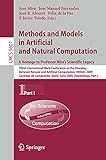Methods and Models in Artificial and Natural Computation. A Homage to Professor Mira's Scientific Legacy [electronic resource] : Third International Work-Conference on the Interplay Between Natural and Artificial Computation, IWINAC 2009, Santiago de Compostela, Spain, June 22-26, 2009, Proceedings, Part I / edited by Jose Mira, José M. Ferrández, Jose-Ramon Alvarez Sanchez, Felix Paz, Javier Toledo.
Contributor(s): Mira, Jose [editor.] | Ferrández, José M [editor.]
| Ferrández, José M [editor.] | Alvarez Sanchez, Jose-Ramon [editor.]
| Alvarez Sanchez, Jose-Ramon [editor.] | Paz, Felix [editor.]
| Paz, Felix [editor.] | Toledo, Javier [editor.]
| Toledo, Javier [editor.] | SpringerLink (Online service)
| SpringerLink (Online service) .
.
Material type:  BookSeries: Theoretical Computer Science and General Issues: 5601Publisher: Berlin, Heidelberg : Springer Berlin Heidelberg : Imprint: Springer, 2009Edition: 1st ed. 2009.Description: XXI, 530 p. online resource.Content type: text Media type: computer Carrier type: online resourceISBN: 9783642022647.Subject(s): Computer science
BookSeries: Theoretical Computer Science and General Issues: 5601Publisher: Berlin, Heidelberg : Springer Berlin Heidelberg : Imprint: Springer, 2009Edition: 1st ed. 2009.Description: XXI, 530 p. online resource.Content type: text Media type: computer Carrier type: online resourceISBN: 9783642022647.Subject(s): Computer scienceA Model of Low Level Co-operativity in Cerebral Dynamic -- On Bridging the Gap between Human Knowledge and Computers: A Personal Tribute in Memory of Prof. J. Mira -- Personal Notes about the Figure and Legate of Professor Mira -- Intelligent Patient Monitoring: From Hardware to Learnware -- A Look toward the Past of My Work with the Professor José Mira -- Remembering José Mira -- Revisiting Algorithmic Lateral Inhibition and Accumulative Computation -- Detection of Speech Dynamics by Neuromorphic Units -- Spatio-temporal Computation with Neural Sensorial Maps -- Knowledge-Based Systems: A Tool for Distance Education -- ANLAGIS: Adaptive Neuron-Like Network Based on Learning Automata Theory and Granular Inference Systems with Applications to Pattern Recognition and Machine Learning -- Neural Prosthetic Interfaces with the Central Nervous System: Current Status and Future Prospects -- Analytical Models for Transient Responses in the Retina -- Analysis of Retinal Ganglion Cells Population Responses Using Information Theory and Artificial Neural Networks: Towards Functional Cell Identification -- On Cumulative Entropies and Lifetime Estimations -- Activity Modulation in Human Neuroblastoma Cultured Cells: Towards a Biological Neuroprocessor -- A Network of Coupled Pyramidal Neurons Behaves as a Coincidence Detector -- Characterisation of Multiple Patterns of Activity in Networks of Relaxation Oscillators with Inhibitory and Electrical Coupling -- Scaling Power Laws in the Restoration of Perception with Increasing Stimulus in Deficitary Natural Neural Network -- Neuron-Less Neural-Like Networks with Exponential Association Capacity at Tabula Rasa -- Brain Complexity: Analysis, Models and Limits of Understanding -- Classifying a New Descriptor Based on Marr's Visual Theory -- Solving theIndependent Set Problem by Using Tissue-Like P Systems with Cell Division -- How to Do Recombination in Evolution Strategies: An Empirical Study -- Serial Evolution -- A Sensitivity Clustering Method for Hybrid Evolutionary Algorithms -- A Genetic Algorithm for the Open Shop Problem with Uncertain Durations -- Genetic Algorithm Combined with Tabu Search for the Job Shop Scheduling Problem with Setup Times -- Prediction and Inheritance of Phenotypes -- Controlling Particle Trajectories in a Multi-swarm Approach for Dynamic Optimization Problems -- Clustering Ensembles Using Ants Algorithm -- The kNN-TD Reinforcement Learning Algorithm -- Recombination Patterns for Natural Syntax -- Computing Natural Language with Biomolecules: Overview and Challenges -- A Christiansen Grammar for Universal Splicing Systems -- DNA Replication as a Model for Computational Linguistics -- jNEPView: A Graphical Trace Viewer for the Simulations of NEPs -- The Problem of Constructing General-Purpose Semantic Search Engines -- Computational Agents to Model Knowledge - Theory, and Practice in Visual Surveillance -- Knowledge and Event-Based System for Video-Surveillance Tasks -- ARDIS: Knowledge-Based Dynamic Architecture for Real-Time Surface Visual Inspection -- SONAR: A Semantically Empowered Financial Search Engine -- KBS in Context Aware Applications: Commercial Tools -- An Architecture Proposal for Adaptive Neuropsychological Assessment -- A Study of Applying Knowledge Modelling to Evidence-Based Guidelines -- Fuzzy Classification of Mortality by Infection of Severe Burnt Patients Using Multiobjective Evolutionary Algorithms -- Knowledge Based Information Retrieval with an Adaptive Hypermedia System -- Reveal the Collaboration in a Open Learning Environment -- Reasoning on the Evaluation of Wildfires Risk Using theReceiver Operating Characteristic Curve and MODIS Images -- Optimised Particle Filter Approaches to Object Tracking in Video Sequences -- Towards Interoperability in Tracking Systems: An Ontology-Based Approach -- Multimodal Agents in Second Life and the New Agents of Virtual 3D Environments -- Application of Artificial Neural Networks to Complex Dielectric Constant Estimation from Free-Space Measurements.
The two-volume set LNCS 5601 and LNCS 5602 constitutes the refereed proceedings of the Third International Work-Conference on the Interplay between Natural and Artificial Computation, IWINAC 2009, held in Santiago de Compostela, Spain, in June 2009. The 108 revised papers presented are thematically divided into two volumes. The first volume includes papers relating the most recent collaborations with Professor Mira and contributions mainly related with theoretical, conceptual and methodological aspects linking AI and knowledge engineering with neurophysiology, clinics and cognition. The second volume contains all the contributions connected with biologically inspired methods and techniques for solving AI and knowledge engineering problems in different application domains.


There are no comments for this item.